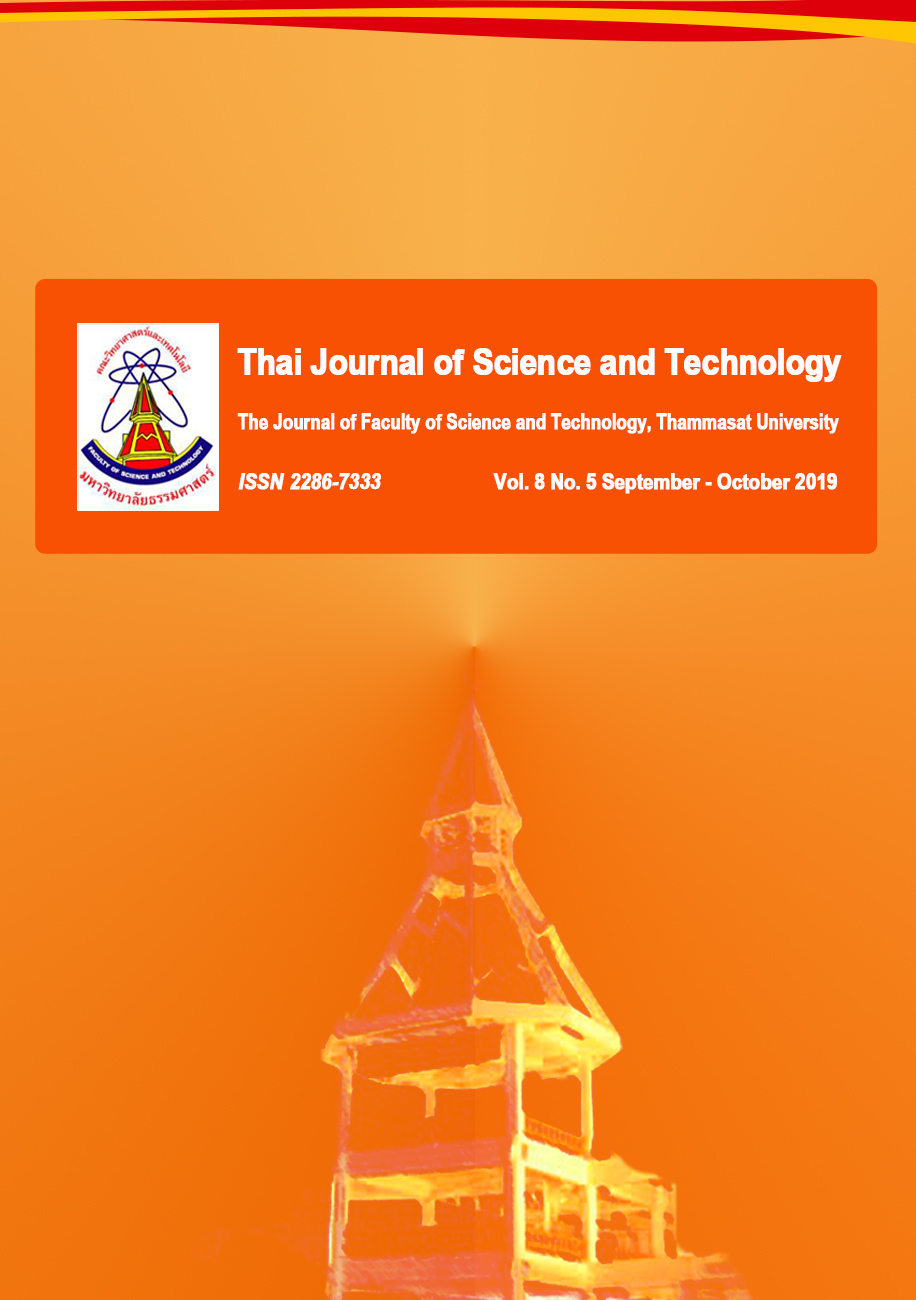Evaluation of Morphological Characteristics of Bhutanese Landrace Chilies (Capsicum spp.)
Main Article Content
Abstract
Abstract
Chili plays an integral part in a different culture. It is cultivated as commercial and in backyards for spices, vegetables, ornamental and medicinal purposes. In Bhutan, chili (Capsicum spp.) is an important crop and is cultivated across the country. Twenty chili varieties cultivated in Bhutan were collected from different chili growing regions to evaluate morphological characteristics at Maejo University, Chiang Mai, Thailand. The experiment was conducted under 50% shade net in a completely randomized design with five replications. The results showed a significant difference among the varieties, the earliest flowering was recorded from 23 to 42 days in 15 varieties and late flowering in 67 days in ‘Dhallay’ variety. The mean plant height, canopy, and stem diameter were 76.3±18.2 cm, 42.7±7.6 cm and 7.5±3.1 mm, respectively, while the mean fruit length, width and weight were 9.8±4.4 cm, 2.1±0.7 cm, and 11.1±9.6 g, respectively. The varieties ‘Tsakaling’ and ‘Indian Fat’ had purple corolla color which indicates Capsicum pubescens Ruiez. & Pav. species. Geographical group analysis showed that varieties introduced from Japan had different characters from those of the Bhutanese landrace varieties except for leaf width, plant height, plant canopy and stem diameter. The results of morphological characteristics from this study will have potential application in chili genetic diversity conservation and plant breeding program.
Keywords: Chili; landrace; morphology; Bhutan
Article Details
บทความที่ได้รับการตีพิมพ์เป็นลิขสิทธิ์ของคณะวิทยาศาสตร์และเทคโนโลยี มหาวิทยาลัยธรรมศาสตร์ ข้อความที่ปรากฏในแต่ละเรื่องของวารสารเล่มนี้เป็นเพียงความเห็นส่วนตัวของผู้เขียน ไม่มีความเกี่ยวข้องกับคณะวิทยาศาสตร์และเทคโนโลยี หรือคณาจารย์ท่านอื่นในมหาวิทยาลัยธรรมศาสตร์ ผู้เขียนต้องยืนยันว่าความรับผิดชอบต่อทุกข้อความที่นำเสนอไว้ในบทความของตน หากมีข้อผิดพลาดหรือความไม่ถูกต้องใด ๆ
References
Agriculture Research and Development Centre, 2016, Technology for chili production in Bhutan, Agriculture Research and Development Centre, Bajo.
Bianchi, P.A., Dutra, I.P., Moulin, M.M., Santos, J.O. and Júnior, A.C.S., 2016, Morphological characterization and analysis of genetic variability among pepper accessions, Ciencia Rural 46: 1151-1157.
Bozokalfa, M.K., Esiyok, D. and Turhan, K., 2009, Patterns of phenotypic variation in a germplasm collection of pepper (Capsicum annuum L.) from Turkey, Spanish J. Agric. 7: 83-95.
Csilléry, G., 2006, Pepper taxonomy and the botanical description of the species, Acta Agron. (Hungary) 54: 151-166.
Dorji, K.D., Dema, Y. and Uden, T., 2009, Effect of different rates and combinations of farm yard manure and inorganic fertilizers on chilli (Capsicum annuum) yield, J. Renew. Nat. Res. Bhutan 5: 1-14.
Ghimiray, M., 2005, Plant Genetic Resources in SAARC Countries: Their Conservation and Management, Bhutan Chapter, Renewable Natural Resources Centre, Wangdue Phodrang.
Ghimiray, M. and Katwal, T.B., 2013, Crop genetic resources for food security and adaptation to climate change: A review and way forward, J. Renew. Nat. Res. Bhutan 9: 1-14.
International Plant Genetic Resources Institute, 1995, Descriptors for Capsicum (Capsicum spp.), International Plant Genetic Resources Institute, Rome.
Jha, T.B., Saha, P.S., Nath, S., Das, A. and Jha, S., 2017, Morphological and cytogenetical characterization of ‘Dalle Khursani’: A polyploid cultivated Capsicum of India, Sci. Hort. 215: 80-90.
Lin, S., Chou, Y., Shieh, H., Ebert, A.W., Kumar, S., Mavlyanova, R. and Gniffke, P.A., 2013, Pepper (Capsicum spp.) germplasm dissemination by AVRDC – The World Vegetable Center: An overview and introspection, Chron. Hort. 53: 21-27.
Ministry of Agriculture and Forests, 2017, Agriculture Statistics 2017, Ministry of Agriculture and Forests, Thimphu.
National Biodiversity Centre, 2015, The history of the introduction and adoption of important food crops in Bhutan rice, maize, potato and chili, Ministry of Agriculture and Forests, Thimphu.
Organisation for Economic Co-operation and Development, 2006, Consensus document on the biology of the Capsicum annuum complex (chili peppers, hot peppers and sweet peppers), Organisation for Economic Co-operation and Development, Paris.
Pickersgill, B., 1997, Genetic resources and breeding of Capsicum spp., Euphytica 96: 129-133.
Sanatombi, K., Sen-Mandi, S. and Sharma, G.J., 2010, DNA profiling of Capsicum landraces of Manipur, Sci. Hort. 124: 405-408.
Thapa, L., 2012, Traditional chilli pepper diversity: Farmer’s perception on its decline in western Bhutan, J. Renew. Nat. Res. Bhutan 8: 90-99.
Thuy, T.L. and Kenji, M., 2015, Effect of high temperature on fruit productivity and seed-set of sweet pepper (Capsicum annuum L.) in the field condition, J. Agric. Sci. Technol. A 5: 515-520.
Ueda, A. and Samdup, T., 2009, Chilli transactions in Bhutan: An economic, social and cultural perspective, Bull. Tibetol. 45: 103-118.
Villota-Cerón, D., Bonilla-Betancourt, M.L., Carmen-Carrillo, H., Juan Jaramillo-Vásquez, J.J. and García-Dávila, M.A., 2012, Morphological characterization of Capsicum spp. accessions from the germplasm collection of Corpoica C.I. Palmira, Colombia. Acta Agron. 61: 16-26.
Walsh, B.M. and Hoot, S.B., 2001, Phylogenetic relationships of Capsicum (solanaceae) using DNA sequences from two noncoding regions: The chloroplast atpB-rbcL spacer region and nuclear waxy introns, Int. J. Plant Sci. 162: 1409-1418.
Xiao-min, Z., Zheng-hai, Z., Xiao-zhen, G., Sheng-li, M., Xi-xiang, L., Chadoeuf, J., and Bao-xi, Z., 2016, Genetic diversity of pepper (Capsicum spp.) germplasm resources in China reflects selection for cultivar types and spatial distribution, J. Integrat. Agric. 15: 1991-2001.
Yamamoto, S., Djarwaningsih, T. and Wiriadinata, H., 2013, Capsicum pubescens (Solanaceae) in Indonesia: Its history, taxonomy, and distribution, Econ. Bot. 67: 161-170.


